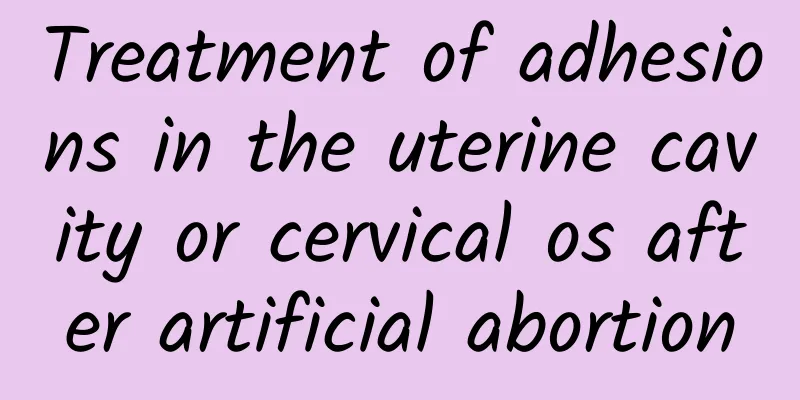Treatment of adhesions in the uterine cavity or cervical os after artificial abortion

|
Abortion is very harmful to women. Patients may experience various complications after the operation, such as incomplete abortion, uterine perforation, abortion syndrome, adhesion of the uterine cavity or the cervical os, etc. If the patient has amenorrhea or oligomenorrhea after abortion, accompanied by periodic lower abdominal distension and pain, or uterine enlargement and blood accumulation, adhesion of the uterine cavity or the cervical os should be considered. Adhesions in the uterine cavity or the cervix are mainly caused by rough suction, repeated operations on the cervix, repeated in and out of the cervix with negative pressure, and healing of endometrial and cervical infections. When treating adhesions in the cervix, a probe should be used to penetrate the cervical canal, slowly separate and probe into the uterine cavity, and dark red, viscous menstrual blood can be seen flowing out. After the accumulated blood has drained away, the cervix can be dilated with a suitable type of cervical dilator. For patients with intrauterine adhesions, a probe or a dilator of appropriate size can be inserted into the uterine cavity and then swung horizontally left and right to separate the intrauterine adhesions, or the adhesions can be separated under direct vision of the hysteroscope. After the adhesions are separated, an intrauterine contraceptive device can be placed, and artificial cyclic therapy can be used for 2 to 3 cycles starting on the day of separation. It should also be noted that if the patient does not pay attention to treatment, uterine infection may occur. In severe cases, it may spread to the pelvic cavity, abdominal cavity and even the whole body, complicated by pelvic inflammatory disease, peritonitis, etc. Therefore, patients need to use antibacterial drugs to prevent infection after separation surgery. TIPS-artificial cycle therapy simulates the production of female sex hormones (estrogen and progesterone) in the human body during the normal menstrual cycle. By artificially administering exogenous sex hormones, the estrogen and progesterone in the patient's body conform to the rules of the normal menstrual cycle, thereby achieving the purpose of regulating the menstrual cycle. |
<<: Can women take birth control pills after painless abortion?
>>: Contraindications for various abortion methods
Recommend
What are the examination items for uterine fibroids?
Uterine fibroids can have a certain impact on fer...
Uterine fibroids are often associated with infertility
Do you know the harm of uterine fibroids? If uter...
The main reasons for irregular menstruation in women
Among the gynecological diseases of women, irregu...
What are the symptoms of female cervical hypertrophy?
Cervical hypertrophy has a certain impact on wome...
Women's problems, women's solutions: Tips for painless abortion
Many women may have many questions about painless...
Is it really a blessing to not gain weight? Don't be silly~3 major health crises are lurking
"Great! You never gain weight!" Most pe...
Experts explain the causes of secondary dysmenorrhea
Secondary dysmenorrhea is relatively rare among d...
Eat out in autumn must eat this 1 pill to detoxify and keep healthy
Have you eaten an apple today? As the saying goes...
The dangers of surgery for cervical precancerous lesions
When it comes to cervical precancerous disease, f...
No need to go hungry! Jung Da-yeon's 10 dietary rules
By Zheng Duolian A weight loss campaign based on ...
What are the hazards of adnexitis?
What are the symptoms of adnexitis? Is it harmful...
Are there obvious symptoms of cervical hypertrophy?
Are the symptoms of cervical hypertrophy obvious?...
What are the common symptoms of uterine fibroids?
What are the common symptoms of uterine fibroids?...
How long does it take to have an abortion during pregnancy?
Nowadays, medicine is developing rapidly, and abo...
What are the dangers of having an IUD inserted directly after an abortion? 3 dangers of having an IUD inserted directly after an abortion
Whether an IUD can be inserted directly after an ...









